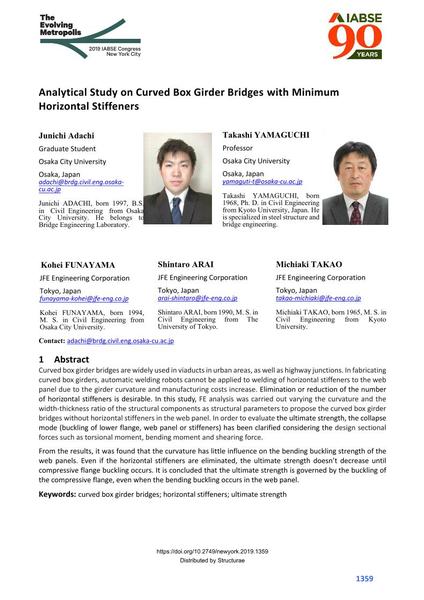Analytical Study on Curved Box Girder Bridges with Minimum Horizontal Stiffeners

|
|
|||||||||||
Détails bibliographiques
| Auteur(s): |
Junichi Adachi
(Osaka City University)
Takashi Yamaguchi (Osaka City University) Kohei Funayama (JFE Engineering Corporation) Shintaro Arai (JFE Engineering Corporation) Michiaki Takao (JFE Engineering Corporation) |
||||
|---|---|---|---|---|---|
| Médium: | papier de conférence | ||||
| Langue(s): | anglais | ||||
| Conférence: | IABSE Congress: The Evolving Metropolis, New York, NY, USA, 4-6 September 2019 | ||||
| Publié dans: | The Evolving Metropolis | ||||
|
|||||
| Page(s): | 1359-1364 | ||||
| Nombre total de pages (du PDF): | 6 | ||||
| DOI: | 10.2749/newyork.2019.1359 | ||||
| Abstrait: |
Curved box girder bridges are widely used in viaducts in urban areas, as well as highway junctions. In fabricating curved box girders, automatic welding robots cannot be applied to welding of horizontal stiffeners to the web panel due to the girder curvature and manufacturing costs increase.Elimination or reduction of the number of horizontal stiffeners is desirable. In this study,FE analysis was carried out varying the curvature and the width-thickness ratio of the structural components as structural parameters to propose the curved box girder bridges without horizontal stiffeners in the web panel. In order to evaluatethe ultimate strength, the collapse mode (buckling of lower flange, web panel or stiffeners) has been clarified considering thedesign sectional forces such as torsional moment, bending moment and shearing force. From the results, it was found that the curvature has little influence on the bending buckling strength of the web panels. Even if the horizontal stiffeners are eliminated, the ultimate strength doesn’t decrease until compressive flange buckling occurs. It is concluded that the ultimate strength is governed by the buckling of the compressive flange, even when the bending buckling occurs in the web panel. |
||||
